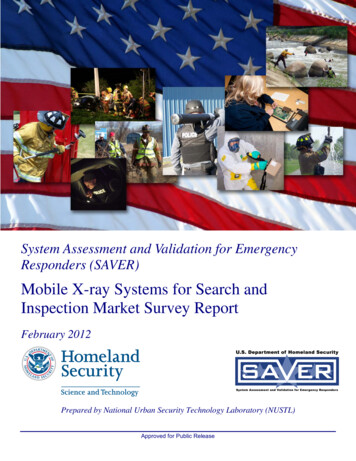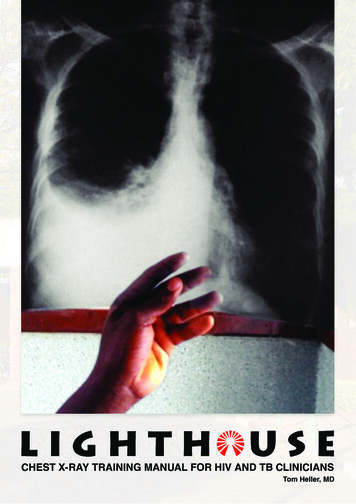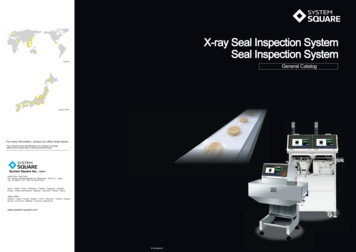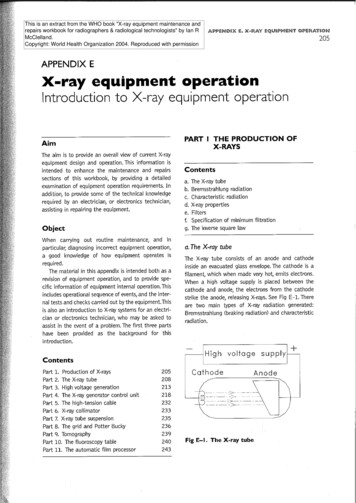
Transcription
fdefeSystem Assessment and Validation for EmergencyResponders (SAVER)Mobile X-ray Systems for Search andInspection Market Survey ReportFebruary 2012Prepared by National Urban Security Technology Laboratory (NUSTL)Approved for Public Release
The Mobile X-ray Systems for Search and Inspection Market Survey Report was preparedby the National Urban Security Technology Laboratory for the SAVER Program of theU.S. Department of Homeland Security, Science and Technology Directorate.The views and opinions of authors expressed herein do not necessarily reflect those of theU.S. Government.Reference herein to any specific commercial products, processes, or services by tradename, trademark, manufacturer, or otherwise does not necessarily constitute or imply itsendorsement, recommendation, or favoring by the U.S. Government.The information and statements contained herein shall not be used for the purposes ofadvertising, nor to imply the endorsement or recommendation of the U.S. Government.With respect to documentation contained herein, neither the U.S. Government nor any ofits employees make any warranty, express or implied, including but not limited to thewarranties of merchantability and fitness for a particular purpose. Further, neither theU.S. Government nor any of its employees assume any legal liability or responsibilityfor the accuracy, completeness, or usefulness of any information, apparatus, product, orprocess disclosed; nor do they represent that its use would not infringe privately ownedrights.
FOREWORDThe U.S. Department of Homeland Security (DHS) established the System Assessment andValidation for Emergency Responders (SAVER) Program to assist emergency respondersmaking procurement decisions. Located within the Science and Technology Directorate (S&T)of DHS, the SAVER Program conducts objective assessments and validations on commercialequipment and systems and provides those results along with other relevant equipmentinformation to the emergency response community in an operationally useful form. SAVERprovides information on equipment that falls within the categories listed in the DHS AuthorizedEquipment List (AEL). The SAVER Program mission includes: Conducting impartial, practitioner-relevant, operationally oriented assessments andvalidations of emergency responder equipment; and Providing information that enables decision-makers and responders to better select,procure, use, and maintain emergency responder equipment.Information provided by the SAVER Program will be shared nationally with the respondercommunity, providing a life- and cost-saving asset to DHS, as well as to Federal, state, and localresponders.The SAVER Program is supported by a network of Technical Agents who perform assessmentand validation activities. Further, SAVER focuses primarily on two main questions for theemergency responder community: “What equipment is available?” and “How does it perform?”As a SAVER Program Technical Agent, the National Urban Security Technology Laboratory(NUSTL) has been tasked to provide expertise in hazard detection, response, and remediationinstruments and techniques. In support of this tasking, NUSTL conducted a market survey ofcommercially available mobile X-ray systems for search and inspection. These mobile X-raysystems fall under the AEL title “System, Mobile Search & Inspection; X-ray,” referencenumber 15IN-00-XRAY.Visit the SAVER library at www.dhs.gov/science-and-technology/SAVER for moreinformation on the SAVER Program or to view additional reports on mobile X-ray systems orother technologies.i
POINTS OF CONTACTNational Urban Security Technology LaboratoryU.S. Department of Homeland SecurityScience and Technology Directorate201 Varick StreetNew York, NY 10014-7447E-mail: nustl@hq.dhs.govWebsite: www.dhs.gov/science-and-technology/SAVERii
TABLE OF CONTENTSForeword . iPoints of Contact. ii1. Introduction . 12. Mobile X-ray Systems Overview . 12.1Current Technologies. 22.1.1 X-ray Generators . 22.1.2 X-ray Detectors/Imaging Systems . 22.1.3 Threat Detection Features. 32.2Applications . 42.3Standards/Regulations. 53. Product Data . 63.1Package and Parcel Screening Systems . 63.1.1 American Innovation, Inc., MXIS-VAN . 93.1.2 Astrophysics, Inc., XIS-Minivan . 93.1.3 Astrophysics, Inc., XIS-Trailer. 103.1.4 Astrophysics, Inc., XIS-Van. 103.1.5 Control Screening, Inc., AUTOCLEAR X-ray Inspection Trailer . 113.1.6 Rapiscan Systems, MobilScan 636SV. 113.1.7 Smiths Detection, ScanTrailer 130100 . 123.1.8 Smiths Detection, ScanTrailer 8585 SA. 123.1.9 Smiths Detection, ScanTrailer 9075-OT . 133.1.10 Smiths Detection, ScanVan 8585 . 133.2Vehicle and Cargo Screening Systems . 143.2.1 American Science and Engineering, Inc., MobileSearch HE . 163.2.2 American Science and Engineering, Inc., Z Backscatter Van . 163.2.3 Rapiscan Systems, Eagle M10 . 173.2.4 Rapiscan Systems, Eagle M4508 . 173.2.5 Rapiscan Systems, Eagle M60 . 183.2.6 Rapiscan Systems, Eagle T10. 193.2.7 SAIC, VACIS M6500 Mobile Imaging System . 19iii
4. Vendor Contact Information. 205. Summary. 21Appendix A.Request for Information . A-1LIST OF TABLESTable 3-1 Product Comparison Matrix for Package and Parcel Screening Systems . 8Table 3-2 Product Comparison Matrix for Vehicle and Cargo Screening Systems . 15Table 4-1 Product and Vendor List. 20iv
Mobile X-ray Systems for Search and Inspection Market Survey Report1.INTRODUCTIONMobile X-ray systems for search and inspection are available in many vehicular configurationssuch as vans, trucks, and trailers. They are used by professionally trained public safety and lawenforcement personnel in various applications. Some systems are designed for inspectingpackages, parcels, and luggage at locations such as concerts, sporting events, or transportationhubs. Other systems are designed to inspect vehicles and cargo. Mobile X-ray systems can detectexplosives, weapons, narcotics, and other threats and contraband.This market survey report is based on information gathered between September 2010 and June2011 from a government-issued Request for Information (RFI) posted on the Federal BusinessOpportunities (FedBizOpps) website (https://www.fbo.gov) as well as a search of vendorwebsites. The equipment addressed in this market survey are X-ray systems mounted on or inwheeled vehicles such as trailers or vans. Hand-carried (i.e., portable) systems are discussed inother SAVER publications. 1For inclusion in this report, the mobile X-ray systems had to meet the following criteria: The entire system including X-ray generator, detector, display, and power source must bemounted in and contained in a wheeled vehicle capable of being driven or towed onpublic or private roads;The system must generate X-rays from a non-radioactive source (gamma-ray systemswere excluded); andThe system must be a commercial off-the-shelf (COTS) product designed for search andinspection applications.Due diligence was exercised to develop a report that is representative of the products in themarketplace.2.MOBILE X-RAY SYSTEMS OVERVIEWX-rays were discovered in 1895 by Wilhelm Roentgen, who received the first Nobel Prize for hiswork. X-rays are electromagnetic radiation emitted by electrons outside the nucleus of an atom 2,and have photon energies typically in the range of 120 electron volts (eV) to 120 kilo-electronvolts (keV), giving them the ability to penetrate and pass through solid objects.Their power to improve health care by imaging internal organs and bones on radiographic filmwas immediately recognized. This discovery drove the rapid development and deployment ofX-ray imaging technology. Although radiographic film is still widely used today in medical andnon-medical applications, X-ray images can now be captured and displayed using detectortechnologies such as scintillators, photodiodes, phosphors, and Geiger counters. These systems1Portable X-ray Systems for Suspicious Package Screening – Focus Group Recommendations, June 2010;Assessment Report, December 2010; Market Survey Report, February 2011; prepared by the Space and NavalWarfare Systems Center Atlantic.2Gamma rays, on the other hand, are emitted by the nucleus through radioactive decay or other nuclear reactions.1
Mobile X-ray Systems for Search and Inspection Market Survey Reporthave the ability to rapidly and repeatedly scan large objects such as luggage, packages, andcontainers, while producing high-resolution images.Driven by the need to intercept explosives, weapons, and other illicit materials before they canbe smuggled aboard commercial airliners or into a restricted area, X-ray systems for search andinspection have advanced significantly. X-ray sources that minimize stray radiation are used withhigh-resolution detectors and image processing software to interrogate objects such as handluggage and baggage. All the capabilities and advanced features of baggage scanning systemsused at airports are now available in van and trailer-mounted systems. These mobile platformscan be used to set up a security checkpoint at locations such as train and bus stations, concerts,sporting events, or political gatherings.Vehicle and cargo-screening X-ray systems have been developed with X-rays powerful enoughto penetrate through several inches of steel and image the contents of trucks and containers.These systems usually employ a boom containing the detector to position it on the opposite sideof the container from the X-ray source. They can be operated in stationary portal mode (scannedvehicles drive through) or in drive-by mode (mobile X-ray system drives alongside stationaryvehicles and containers). As explained in Section 2.1.3.2, systems that employ backscatterX-rays can operate in drive-by mode with no need for an extended boom.2.1Current TechnologiesMobile X-ray systems consist of an X-ray generator, an X-ray detector with image capturingcapability, and a display. Software is often included to help interpret the images and identifythreats.2.1.1X-ray GeneratorsX-ray generators are devices designed to emit X-radiation in a collimated beam at a specificenergy or energies. Mobile X-ray systems typically employ an X-ray tube, which is a vacuumtube applied with a high voltage to produce a beam of electrons which then emit X-rays afterstriking a dense metal target. The energy of the X-ray photons produced corresponds with thevoltage on the X-ray tube. For instance, a tube with 100 kilovolts (kV) applied to it will producea beam of electrons with maximum energy of 100 keV, which in turn will produce X-rays withmaximum energy of 100 keV. Shielding materials and collimators produce a targeted beam thatminimizes stray radiation.X-ray generators employed by vehicle and cargo inspection systems typically use an X-ray tubecontaining a linear accelerator (LINAC) which greatly increases the velocity of electrons bysubjecting them to a series of oscillating electric potentials. This method produces X-rays on theorder of 1 to 10 mega-electron volts (MeV). These high-energy X-rays can penetrate throughseveral inches of steel and provide high-quality images of the contents of trucks and containers.2.1.2X-ray Detectors/Imaging SystemsVirtually all mobile X-ray systems using film as the detection medium have changed to eitherdigital radiography or computed radiography imaging systems. Digital radiography capturesX-ray images using digital sensors. Computed radiography captures X-ray images using animage plate of photostimulable phosphors.2
Mobile X-ray Systems for Search and Inspection Market Survey Report2.1.2.1 Digital RadiographyDigital radiography (DR) uses a variety of sensor technologies to produce digitized imagesindirectly but rapidly from X-ray signals. One approach uses electronics constructed onamorphous (non-crystalline, or disordered) silicon deposited on a flat glass panel. The panel isthen coated with a scintillator (for example, gadolinium oxysulfide) that generates light whenilluminated with X-rays. The light is detected with an array of photodiodes. Amorphous thin-filmtransistors couple each photodiode to the readout electronics. Spatial resolution (the smallestdetail that can be seen in the image) for these systems is on the order of 0.005 inches (0.127mm), determined by the diameter of the photodiode. The data can be read and an imagegenerated in less than 3 seconds. Amorphous silicon sensor arrays on glass panels can be aslarge as 16 inches by 20 inches, which is more than adequate to image most suspicious objects.This type of system is commonly known as an “amorphous silicon panel” or a “photodiodearray.”Other scintillators (e.g., sodium iodide) and detectors (e.g., charge coupled devices) may be usedin DR systems, with trade-offs in such factors as cost, resolution, sensitivity, plate size, andmobility. DR systems have the advantage of fast imaging and instant reusability. In addition, it ispossible to illuminate the target with multiple X-ray energies per image. This tool is useful fordifferentiating organic and inorganic substances. Disadvantages of DR systems include the highcost and limited durability of the fragile flat-panel detector.2.1.2.2 Computed RadiographyComputed radiography (CR) captures X-ray images on an image plate, which is a flexible plasticsheet coated with a photostimulable phosphor (PSP) crystal, typically barium fluorobromidedoped with europium. X-rays incident on the PSP excite electrons which are trapped in “colorcenters” in the crystal lattice, creating a latent image that is stable for several days. The image isobtained by using an image plate reader which scans the image plate with a tightly focusedvisible-wavelength laser beam; this causes the trapped electrons to emit blue-violet light that isdetected by a photomultiplier tube.Computed radiography systems generally have superior image quality and higher resolutioncompared with digital radiography. However, image processing time is much higher. A 14 inchby 17 inch image plate can be read in approximately 90 seconds using the best availabletechnology. The image must then be erased by exposure to intense white light before the imageplate may be reused. The image plate must be deployed (preferably using robotic equipment) andreturned to the reader for analysis, and this sequence repeated for any additional images.2.1.3Threat Detection Features2.1.3.1 Multi-energy X-raysDifferent materials absorb high and low-energy X-rays at differing rates. By comparing highenergy and low-energy signals obtained from transmission X-rays, it is possible to determine theatomic composition of a substance and differentiate organic and inorganic materials. One way todo this is to illuminate the target with different X-ray energies. The alternative is to use a multilayered detector in which the layers are designed to read X-rays in different energy ranges. The3
Mobile X-ray Systems for Search and Inspection Market Survey Reportalgorithms needed to make these calculations are complex, but easily handled by today’s rapidimaging systems and high-speed computers. Most multi-energy X-ray systems display certainmaterial types in different colors. For instance, organic items may display in orange, inorganicitems in blue, mixed items in green, and high density items in red. By distinguishing organicitems from inorganic, substances such as explosives and narcotics are more easily identified.2.1.3.2 Backscatter X-raysConventional X-ray images are generated from transmission X-rays, those that pass through anobject. It is now possible to create images from X-rays that are reflected, or backscattered, fromobjects. Less dense materials more efficiently backscatter low-energy X-rays and thus aredifferentiated from high-density materials. In addition, backscatter technology preferentiallyhighlights organic materials such as explosives, narcotics, and stowaways. Another advantage ofthis technology is that an object can be scanned without access to both sides, as is needed withtransmission X-rays.2.1.3.3 Software FeaturesMobile X-ray system software may include features that facilitate threat detection. Operators canarchive and annotate images, zoom in on a region, sharpen edges, and correct for imagedistortion. Some systems will display the atomic number of items scanned, alarm on items whosedensity is above a set threshold, and automatically highlight objects such as weapons deemed tobe a threat. Operator training and performance measurement features such as threat imageprojection (TIP) are often included in software packages. TIP digitally inserts threatening imagesrandomly into scanned objects.2.2ApplicationsApplications for mobile X-ray systems fall into two broad categories: Package and parcel screening; andVehicle and cargo screening.Package and parcel screening systems have all the capabilities of stationary cabinet X-raysystems that are found at airports, government buildings, and post offices. Mounted into vans ortrailers they can quickly be deployed to areas or events in which a stationary screening system isnot present. Such locations may include train stations, bus depots, airport and military baseperimeters, concerts and sporting events, political gatherings, mail processing facilities, ports,and border crossings. Items screened can be luggage, handbags, backpacks, envelopes, boxes,and other packages. See Table 3-1 for limits on size and weight.Vehicle and cargo screening systems have the capability to image the contents of cars, trucks,containers, and large boxes and packages. These systems, mounted in trucks with a deployableboom, can be set up as portal monitors to screen passing vehicles at roadways, ports, bordercrossings, military bases, and other traffic locations. They can also be used to screen parkedvehicles, containers, or other large items by moving alongside them with the boom positioned onthe opposite side of the object. Other systems, using backscatter X-rays, can scan vehicles andcargo in drive-by mode. See Table 3-2 for limits on the size of vehicles and cargo.4
Mobile X-ray Systems for Search and Inspection Market Survey ReportMobile X-ray systems can be used to detect threats and contraband including but not limited tothe following items: 2.3Explosives and explosive ol;Tobacco; andAgricultural products.Standards/RegulationsNo standards have been mandated specifically for X-ray systems contained in vehicles.However, there are standards and regulations that apply to both cabinet X-ray systems and tovehicle and cargo X-ray inspection systems.American National Standards Institute (ANSI) Standard N42.44-2008 establishes technicalperformance requirements for cabinet X-ray systems used at checkpoints. Title 21 of the Code ofFederal Regulations, Section 1020.40, specifies radiation emission limits and other safety andperformance standards. All mobile X-ray package and parcel screening systems should complywith these standards and regulations and be operated in accordance with Federal and stateradiation protection standards.ANSI N42.46-2008 is the imaging performance standard for cargo and vehicle X-ray screeningsystems. ANSI N43.3-2008 gives guidance for the design and use of installations that usedevices that generate X-rays up to 10 MeV in energy. All mobile X-ray systems that screenvehicles and cargo should comply with these standards.Some vendors reported compliance with ASTM International (formerly known as AmericanSociety for Testing and Materials) F792-08, which prescribes the standard practice to measureimaging performance of X-ray systems used to screen for prohibited items such as weapons,explosives, and explosive devices in baggage, packages, cargo, or mail. This practice is intendedto establish whether an X-ray system meets the manufacturer’s specification or if the system’sperformance has deteriorated over time. It is based on the use of standard test objects todetermine the performance level of the systems. Minimum performance levels, eitherquantitative or qualitative, are not established by the practice.Emergency responders could use commercially available test kits to evaluate mobile X-raysystems. These kits employ test objects to assess nine parameters of the image quality of anX-ray screening image system: wire display, useful penetration, spatial resolution, simplepenetration, thin organic imaging, sensitivity, organic/inorganic differentiation, organicdifferentiation, and useful organic differentiation.Finally, it should be noted that the National Institute of Justice (NIJ) Standard 0603.01establishes performance requirements and testing methods for portable (i.e., handheld) X-raysystems for use in bomb disarming operations. This standard does not apply to cabinet X-raysystems or mobile X-ray systems for search and inspection.5
Mobile X-ray Systems for Search and Inspection Market Survey Report3.PRODUCT DATAThe mobile X-ray systems identified in this market survey report are categorized here accordingto whether they are designed to screen packages and parcels or to screen vehicles and cargo.3.1Package and Parcel Screening SystemsThe package and parcel screening systems range in price from 109,000 to 172,209. They arehoused in vans, minivans, or trailers having weights ranging from 8,500 pounds to 16,000pounds. Product data for these systems is presented in a product comparison matrix (Table 3-1)and in subsequent product descriptions.Products are listed in alphabetical order by vendor. The product data was obtained directly fromthe vendor, product specification sheets, and the vendor’s website. The information obtainedfrom these sources has not been independently validated by the SAVER Program.Features in Table 3-1 are defined as follows:Cost indicates the price of the system as quoted by the vendor in U.S. dollars.GSA Schedule indicates whether or not the system is listed on the U.S. General ServicesAdministration schedule.System Weight indicates the weight in pounds of the entire mobile X-ray system including thevehicle it is mounted in.Tunnel Dimensions indicates the width and height of the tunnel opening through whichpackages and parcels to be X-rayed travel by means of the system’s conveyor. Values arerounded to the nearest inch.Maximum Package Weight indicates the maximum weight in pounds of packages and parcelsthat can be handled by the system’s conveyor.Operating Temperature indicates the temperature range under which the system can operate.Operating Relative Humidity indicates the relative humidity range under which the system canoperate.Cable Length for Remote Operation indicates the length of cable in feet provided for operatingthe system and viewing images at a remote distance from the object being X-rayed.X-ray Energy indicates the maximum X-ray photon energy in keV produced by the system.X-ray Penetration indicates the typical penetration into steel of X-rays produced by the system.Values are specified in millimeters (mm).Spatial Resolution indicates the typical size of the smallestpossible feature that can be detected in images produced by theX-ray system. Values are given in American wire gauge(AWG), a system for specifying the diameter and othercharacteristics of wires. The gauge reported corresponds to thediameter of the wire, with higher AWG values corresponding tosmaller diameters and, therefore, better spatial resolution.Diameters of commonly specified AWG values are given 30.1010.08970.0799
Mobile X-ray Systems for Search and Inspection Market Survey ReportMulti-energy X-rays indicates whether or not the system produces a multi-energy X-rayresponse that can be used to differentiate organic and inorganic substances.Backscatter X-rays indicates whether or not the system uses backscatter X-rays. BackscatterX-rays do not penetrate through the target object, but are deflected at an angle by a processcalled Compton scattering. Backscatter X-rays are useful in determining density of materials andhighlighting organic materials.Density Threshold Alert indicates whether or not the system can generate an alarm when ascanned object has a density that exceeds a user specified threshold.Automatic Atomic Number Measurement indicates whether or not the system can measure anddisplay the atomic number measurement of objects or regions in a scanned image.7
Mobile X-ray Systems for Search and Inspection Market Survey es125,000NA16,00040 x 40 331 §140,616Yes8,56040 x 40363145,101No11,24352 x 40441129,910No8,70834 x 34441139,554No9,58036 x 30331172,209Yes8,70834 x 34441AUTOCLEARControl Screening,X-ray InspectionInc.TrailerMobilScan Rapiscan Systems636SVScanTrailer 130100Smiths DetectionScanTrailer 8585SAScanTrailer 9075OTScanVan 858544012,100 ‡ 40 x 404408,50040 x 4044013,700 ‡ 40 x 40440Notes:* Remote operation is an optional feature - information on cable length is not available;† 180 keV is optional;‡ Weight may vary depending on chassis purchased;§ 887 pounds optional.Density ThreshholdAlertAutomatic AtomicNumber MeasurementXIS-Minivan40 x 40Backscatter X-rays11,600Multi-energy X-raysNA32 11332 10432 10432 104095095095095Opt 740YesNoYesYes2001653740YesNoYesYes32 10410 95Opt *1402940YesOptYesYes32 10432 10432 10432 10432 10459510 9010 9010 9010 OptOptX-ray Penetration(mm steel)Spatial Resolution(AWG)NAX-ray energy (keV)MXIS-VANProductOperatingTemperature ( F)Operating RelativeHumidity (%RH)Cable Length forRemote Operation(feet)System Weight(pounds)Astrophysics, Inc.GSA ScheduleAmericanInnovation, Inc.Cost ( )VendorTunnel Dimensions(Width x Height)(inches)Maximum PackageWeight (pounds)Table 3-1 Product Comparison Matrix for Package and Parcel Screening SystemsAbbreviations:AWG American wire guage; F degrees Fahrenheit; GSA General Services Administration;keV kilo-electron volts; mm millimeters; NA information not available;Opt optional feature; %RH percent relative humidity.8
Mobile X-ray Systems for Search and Inspection Market Survey Report3.1.1American Innovation, Inc., MXIS-VANPRICE:Information not availableAPPLICATION:Package and parcel screeningX-RAY ENERGY: 160 keVDETECTOR TYPE: Photodiode arrayIMAGING TYPE:Digital radiographyThe MXIS-VAN is a mobile X-ray screening system contained in a Ford E-450 heavy-dutycommercial van. This system features the CXIS-4040 computerized X-ray inspection system, aclimate controlled operator’s console, and a diesel generator which powers all systems on thevehicle. Packages are screened by placing them on a conveyor which has a tunnel opening 40inches (1,016 mm) wide by 40 inches (1,016 mm) high. There are openings on both sides of thevan to accommodate package entry and exit. The CXIS-4040 X-ray system uses a 160-keVX-ray generator which produces X-rays that will penetrate 29 mm of steel. The detector is amulti-energy photodiode array.Images are
Mobile X-ray systems consist of an X-ray generator, an X-ray detector with image capturing capability, and a display. Software is often included to help interpret the images and identify threats. 2.1.1 X-ray Generators . X-ray generators are devices designed to emit X-radiation in a collimated beam at a specific energy or energies.










